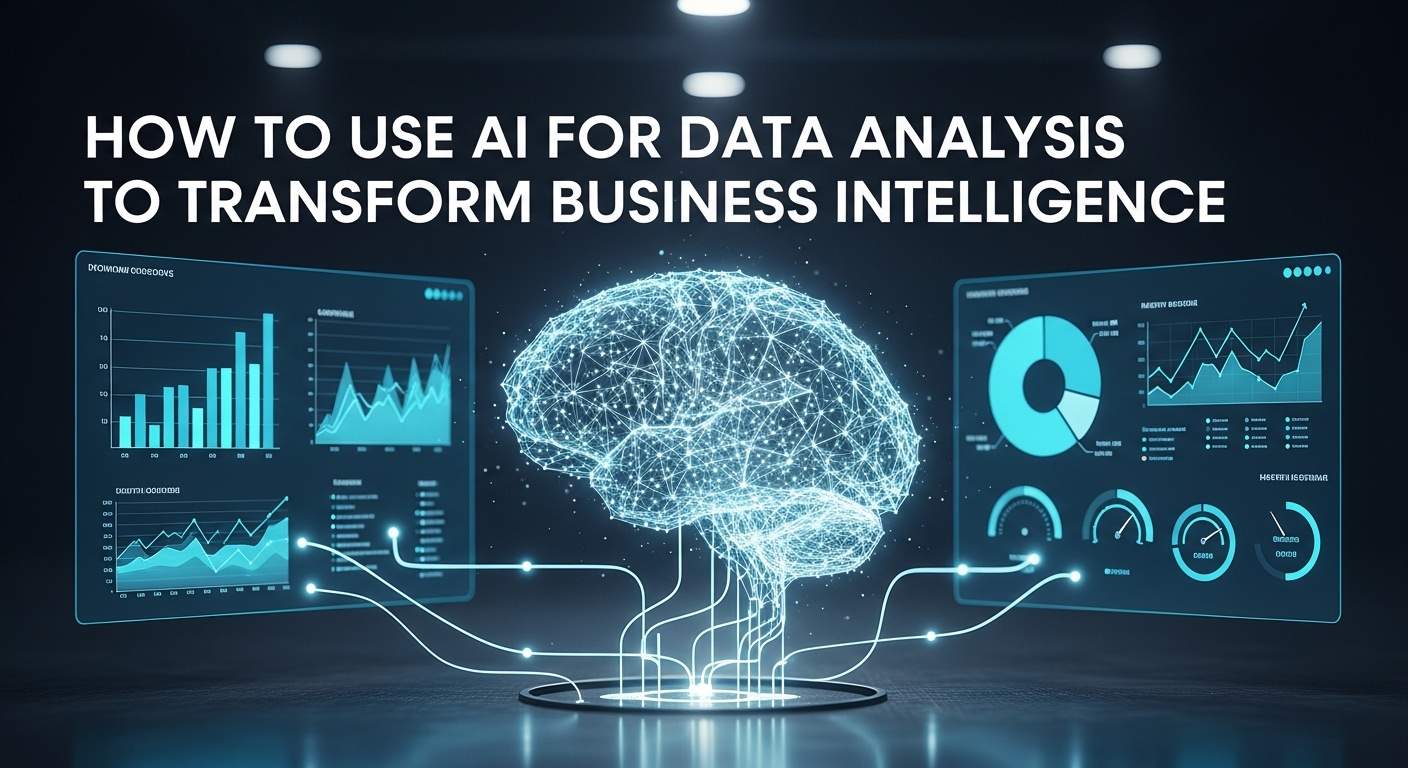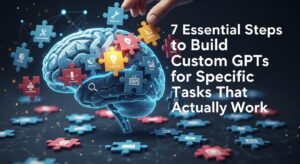Artificial intelligence is revolutionizing how businesses extract insights from their data. Organizations that leverage artificial intelligence for analytical processes see up to 73% faster decision-making and 58% more accurate predictions compared to traditional methods.
This comprehensive guide reveals how to harness AI for data analysis and reporting, transforming your raw data into powerful business intelligence that drives strategic decisions.
What Is AI for Data Analysis?
AI for data analysis combines machine learning algorithms, natural language processing, and automated pattern recognition to process vast datasets quickly and accurately. Unlike traditional analytics that require manual intervention, AI systems can identify trends, anomalies, and correlations autonomously.
The technology encompasses several key components:
- Machine Learning Models that learn from historical data patterns
- Natural Language Processing for analyzing text-based data sources
- Computer Vision for processing visual data elements
- Automated Reporting Systems that generate insights continuously
Modern AI for data analysis platforms like Tableau’s Einstein Analytics, Microsoft Power BI AI, and Google Cloud AutoML democratize advanced analytics for businesses of all sizes.
7 Essential Ways to Implement AI for Data Analysis
1. Automated Pattern Recognition Using Machine Learning
AI for data analysis excels at identifying hidden patterns that human analysts might miss. Machine learning algorithms can process millions of data points simultaneously, detecting correlations across multiple variables.
Key implementation strategies:
- Deploy clustering algorithms to segment customer behaviors
- Use anomaly detection models to identify outliers and fraud
- Implement time-series analysis for forecasting trends
- Apply classification models for predictive categorization
Case Study: Netflix uses machine learning algorithms to analyze viewing patterns across 200+ million subscribers, identifying content preferences that inform their $15 billion content investment strategy.
2. Natural Language Processing for Unstructured Data
Approximately 80% of business data exists in unstructured formats like emails, social media posts, and customer reviews. AI for data analysis through NLP transforms this text data into actionable insights.
Implementation approaches include:
- Sentiment analysis of customer feedback and social media mentions
- Topic modeling to identify emerging themes in support tickets
- Entity extraction from legal documents and contracts
- Automated summarization of research reports and market intelligence
Tools like IBM Watson Natural Language Understanding and AWS Comprehend provide enterprise-ready NLP capabilities.
3. Predictive Analytics and Forecasting
AI for data analysis transforms historical data into future insights through sophisticated forecasting models. These systems can predict market trends, customer behavior, and operational requirements with remarkable accuracy.
Forecasting Application | Accuracy Improvement | Time Savings |
Sales Predictions | 85% vs traditional methods | 60% faster |
Inventory Management | 92% demand accuracy | 45% reduction in stockouts |
Financial Modeling | 78% better risk assessment | 70% faster reporting |
4. Real-Time Data Streaming and Analysis
Modern AI data analysis platforms process data streams in real-time, enabling immediate responses to changing conditions. This capability is crucial for applications like fraud detection, supply chain optimization, and dynamic pricing.
Implementation considerations:
- Choose streaming platforms like Apache Kafka or Amazon Kinesis
- Design low-latency machine learning models for instant decision-making
- Implement automated alerting systems for critical threshold breaches
- Create real-time dashboards for continuous monitoring
5. Automated Report Generation and Data Storytelling
AI for data analysis includes sophisticated reporting capabilities that automatically generate insights and visualizations. These systems can create executive summaries, operational reports, and analytical narratives without manual intervention.
Advanced features include:
- Dynamic chart and graph generation based on data significance
- Automated insight extraction with natural language explanations
- Customized reporting templates for different stakeholder groups
- Interactive dashboards with drill-down capabilities
6. Data Quality Enhancement and Cleansing
AI for data analysis significantly improves data quality through automated cleansing and validation processes. Machine learning models can identify inconsistencies, duplicates, and errors that manual processes often miss.
Data quality improvements include:
- Automated duplicate detection with 95%+ accuracy
- Missing value imputation using advanced statistical methods
- Data standardization across multiple source systems
- Continuous monitoring for data drift and quality degradation
7. Advanced Data Visualization and Interactive Analytics
Modern AI for data analysis platforms create sophisticated visualizations that adapt to user behavior and data characteristics. These systems can automatically select optimal chart types, highlight significant trends, and suggest relevant analyses.
Key visualization capabilities:
- Automated chart selection based on data types and relationships
- Interactive filtering and exploration tools
- Augmented analytics with AI-generated insights
- Mobile-optimized dashboards for on-the-go access
Best Practices for Implementing AI Data Analysis
Start with Clear Objectives
Successful AI for data analysis projects begin with well-defined business objectives. Identify specific questions you want to answer and metrics you want to improve before selecting tools and techniques.
Essential planning steps:
- Define key performance indicators (KPIs) aligned with business goals
- Establish baseline metrics for measuring AI implementation success
- Create data governance frameworks for quality and security
- Design change management processes for user adoption
Choose the Right AI Tools and Platforms
The AI for data analysis landscape includes numerous specialized tools. Selection criteria should include:
Evaluation Factor | Weight | Key Considerations |
Scalability | 25% | Handle growing data volumes and user bases |
Integration | 20% | Connect with existing systems and data sources |
Usability | 20% | Accessible to both technical and business users |
Cost | 15% | Total cost of ownership including licensing and maintenance |
Security | 20% | Data protection and compliance capabilities |
Ensure Data Quality and Governance
AI for data analysis depends on high-quality input data. Implement comprehensive data governance practices including:
- Regular data audits and quality assessments
- Standardized data collection and storage procedures
- Access controls and permission management systems
- Documentation of data lineage and transformation processes
Common Challenges and Solutions in AI Data Analysis
- Data Silos and Integration Issues: Many organizations struggle with fragmented data sources that prevent comprehensive analysis. AI for data analysis requires integrated datasets for optimal performance.
- Solution: Implement data integration platforms like Informatica or Talend that can automatically map and combine data from multiple sources.
- Skills Gap and User Adoption: The complexity of AI for data analysis can intimidate non-technical users, limiting adoption and value realization.
- Model Accuracy and Bias: AI for data analysis models can produce inaccurate results or perpetuate existing biases in training data.
- Solution: Implement model validation frameworks, use diverse training datasets, and establish ongoing monitoring procedures to detect and correct bias issues.
Future Trends in AI for Data Analysis
- Augmented Analytics: The next generation of AI for data analysis will feature augmented analytics that automatically generate insights, suggest analyses, and create explanatory narratives. Gartner predicts that augmented analytics will become a dominant driver of new purchases of analytics and BI platforms.
- Edge AI Analytics: AI for data analysis is moving closer to data sources through edge computing implementations. This trend enables real-time processing of IoT sensor data, mobile applications, and distributed systems without cloud connectivity requirements.
- Democratized Machine Learning: No-code and low-code platforms are making AI for data analysis accessible to business users without programming skills. These tools will expand AI adoption across organizations and enable citizen data scientists.
Getting Started with AI for Data Analysis
Step 1: Assess Your Current Analytics Capabilities
Evaluate existing data infrastructure, analytical tools, and team skills to identify gaps and opportunities for using AI for data analysis.
Step 2: Select a Pilot Project
Choose a well-defined, manageable project that demonstrates clear value from AI for data analysis. Successful pilot projects typically:
- Address specific business pain points
- Have access to quality historical data
- Include measurable success criteria
- Involve engaged stakeholders
Step 3: Build Your AI Analytics Team
Successful AI for data analysis requires diverse skill sets including:
- Data scientists for model development and validation
- Data engineers for infrastructure and pipeline management
- Business analysts for requirement gathering and insight translation
- Domain experts for context and business knowledge
Conclusion
AI for data analysis represents a transformative opportunity for organizations seeking competitive advantages through data-driven decision making. The seven implementation strategies outlined in this guide provide a roadmap for leveraging artificial intelligence to unlock valuable insights from your data assets.
Success requires careful planning, appropriate tool selection, and commitment to data quality and governance practices. Organizations that invest in AI for data analysis capabilities position themselves to respond quickly to market changes, identify new opportunities, and optimize operational efficiency.











